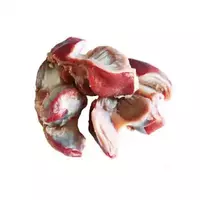Turkey ventricles

As you know, the turkey ventricles consist of four layers of muscles directed in different directions. The structure of the turkey ventricles is dense, they taste quite specific, but no less pleasant. The most useful and tasty are the cooled turkey ventricles. Nevertheless, it is worth remembering that the shelf life of this offal does not exceed 2 days, and therefore you always need to pay special attention to the production date when purchasing cooled turkey ventricles.
To date, turkey ventricles (they are also called "navels") both purified and uncleaned enter the retail network. In any case, before starting the process of preparing this offal, it must be thoroughly washed with running water, cut films and grease, and get rid of sand that may be contained in the ventricular cavity.
By the way, the younger the turkey ventricles, the faster they can be prepared: old giblets cook for about
1. 5-2 hours, while it takes about 40 minutes to prepare young ones. Some culinary experts prefer to cook turkey ventricles in a pressure cooker - so their cooking time is halved.
In cooking, turkey ventricles can be used either alone or in combination with the heart or liver of a bird. A classic dish is turkey-gutted broth or noodles. Some people like to cook whole turkey ventricles, while others are used to cutting them in half or even into small pieces. In general, turkey ventricles are boiled (the longer they become softer and softer), baked under cheese, stewed (in sour cream, cream or tomato sauce), prepared from them gulash, stew and aza.
Often, chopped turkey ventricles are used as one of the components of mince for stuffing poultry. As a side dish, cereals, vegetables, mushrooms and pasta are perfect for turkey ventricle dishes. Boiled turkey ventricles give a pleasant taste to cold snacks and salads.
It is worth noting that during the heat treatment, the turkey ventricles are able to absorb the aromas of various spices and spices. In addition, in the food industry, turkey ventricles, like chicken ventricles, are sometimes used in the manufacture of pepsin, which is necessary for cheese makers instead of the rennet enzyme.
Turkey ventricles contain a full-fledged animal protein, so the benefits of this product for the human body are obvious. In addition, they contain potassium, phosphorus, zinc and iron, as well as folic acid, vitamin E, C, PP and group B along with polyunsaturated fatty acids.
turkey ventricles 118 kCal
Energy value of turkey ventricles (Ratio of proteins, fats, carbohydrates - ju):
Proteins: 19.14 (~ 77 kCal)
Fats: 4.58 g. (~ 41 kCal)
Carbohydrates: 0 g (~ 0 kCal)
Energy ratio (bj | y): 65% | 35% | 0%
 Español
Español Français
Français Português
Português Русский
Русский 简体中文
简体中文 繁體中文
繁體中文 日本語
日本語 한국어
한국어 العربية
العربية Türkçe
Türkçe Қазақ
Қазақ Deutsch
Deutsch Italiano
Italiano Українська
Українська
